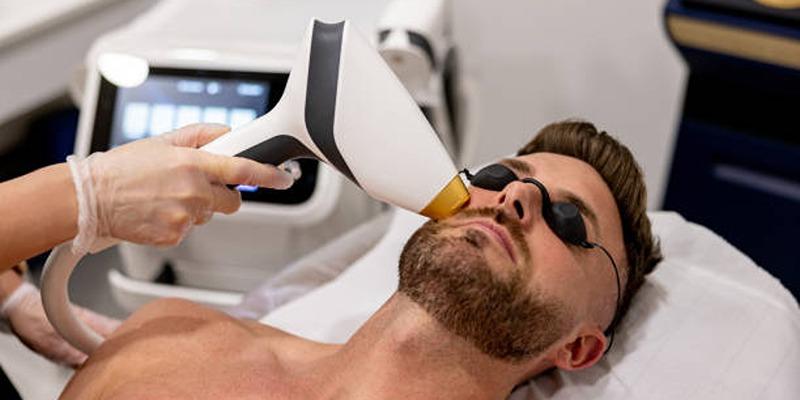Understanding the Differences: Electrolysis Versus Laser Hair Removal
Mar 08, 2024 By Nancy Miller
Unwanted body hair is a common concern that plagues individuals seeking a smooth and hair-free skin experience. This quest often leads to the exploration of diverse hair removal methods. Among these methods, electrolysis and laser hair removal stand out as popular choices due to their proven effectiveness. Electrolysis involves the use of electric currents to target hair follicles, while laser hair removal utilizes concentrated beams of light to achieve hair reduction. Understanding the subtle differences between these techniques is crucial for individuals to make an informed decision aligned with their unique preferences and needs.
Electrolysis:

Electrolysis, a proven method for permanent hair removal, has been trusted for years. During the procedure, a fine probe is inserted into each hair follicle to deliver a small electrical current, targeting the follicle's growth center known as the papilla. By effectively disrupting the hair follicle's regrowth capability, electrolysis guarantees long-term results with permanent hair removal. This precise process offers individuals a reliable solution for achieving smooth, hair-free skin over time.
Key Features of Electrolysis:
- Precision: Electrolysis is a precise hair removal method that targets each hair follicle individually, ensuring thorough treatment. This technique is highly effective for addressing hair removal in smaller, delicate areas like the eyebrows, upper lip, and chin, providing long-lasting results and smooth skin.
- Versatility: Unlike laser hair removal, which targets the hair follicle with a concentrated beam of light, electrolysis is a method that involves the insertion of a tiny probe into the hair follicle and uses a low-level electrical current to destroy the hair root. This versatility allows electrolysis to effectively treat all skin and hair types, including fine, light-colored hair that may not be effectively treated with laser technology.
- Permanent Results: Electrolysis stands out as the singular hair removal technique acknowledged by the FDA for its ability to deliver permanent results. Through regular treatment sessions, electrolysis offers a reliable solution to permanently eliminate unwanted hair, promoting long-lasting smoothness and confidence for individuals seeking a lasting hair removal solution.
- Pain Levels: The sensation experienced during electrolysis treatment can vary from person to person, but it is typically manageable. Most individuals describe it as a stinging or pricking sensation that occurs when the electric current targets the hair follicles, leading to a gradual reduction in hair growth over time. This process involves the destruction of the hair follicles, providing a long-lasting solution for unwanted hair.
Pros and Cons:
Pros:
- Achieves permanent hair removal
- Suitable for all skin and hair types
- Precise targeting of individual hair follicles
- Offers versatility in treating delicate areas
Cons:
- Requires multiple sessions to achieve desired results
- Can be time-consuming
- May cause mild discomfort during treatment
Laser Hair Removal:

Laser hair removal is a popular cosmetic procedure that harnesses the power of highly concentrated light beams to target the pigment (melanin) present in hair follicles. When these beams of light come into contact with the melanin, they are absorbed, converted into heat, and effectively disrupt the follicle, thus preventing future hair growth. This method is known for its efficiency, especially for individuals with dark, coarse hair who seek a long-term solution for hair removal.
Key Features of Laser Hair Removal:
- Speed: Laser hair removal treatments are known for their efficiency in covering larger areas of the body swiftly when compared to electrolysis. This speed and effectiveness make laser hair removal an optimal choice for treating expansive regions such as the legs, back, and chest. The precision and targeted approach of laser treatments also contribute to their popularity, offering a comfortable and convenient solution for those seeking hair removal in these common areas.
- Efficiency: With each precise pulse of the laser, advanced laser hair removal technology can effectively target multiple hair follicles simultaneously. This innovative approach not only ensures efficiency but also makes it ideal for treating larger areas with speed and accuracy.
- Predictability: While laser hair removal offers long-term reduction in hair growth by targeting the hair follicles with laser light, it typically requires multiple sessions spaced over a period of time to achieve optimal results. The treatment works by damaging the hair follicles to inhibit future hair growth, but since hair grows in cycles, follow-up maintenance treatments may be necessary to sustain the reduction and ensure lasting smooth skin.
- Sensations: During laser hair removal, many individuals describe the sensation as akin to a quick snap of a rubber band against the skin. To enhance comfort during the procedure, cooling devices or numbing creams can be employed to reduce any potential discomfort that may arise.
Pros and Cons:
Pros:
- Faster and more efficient compared to electrolysis
- Suitable for treating larger areas of the body
- Technology allows for precision targeting
- Offers long-term hair reduction
Cons:
- Not approved for permanent hair removal by the FDA, may require maintenance sessions.
- More effective on individuals with darker, coarse hair.
- May cause mild discomfort during treatment.
Differences between Electrolysis and Laser Hair Removal:
Mechanism:
Electrolysis is a method that destroys hair follicles one by one by applying electrical currents, which is a precise and thorough process. On the other hand, laser hair removal works by targeting multiple follicles at once using light energy, making it a faster but effective option for hair removal treatments.
Effectiveness:
Electrolysis, a method of hair removal, offers permanent results by targeting individual hair follicles, making it a thorough and lasting solution. On the other hand, laser hair removal, while providing long-term reduction, works by damaging hair follicles to slow down hair growth. Although it may require maintenance sessions, it is known for its effectiveness in reducing hair growth over time.
Suitable Candidates:
Electrolysis, a method suitable for all skin and hair types, involves the use of a fine probe inserted into each hair follicle to deliver a small amount of electrical current, destroying the follicle's ability to regrow hair. On the other hand, laser hair removal, which works best for individuals with light skin and dark, coarse hair, uses concentrated light to target hair follicles, inhibiting their growth over time.
Conclusion:
Choosing between electrolysis and laser hair removal depends on various factors, including skin and hair type, treatment goals, and individual preferences. While electrolysis ensures permanent hair removal, laser hair removal offers efficient reduction in hair growth with fewer treatment sessions. Consulting with a qualified dermatologist or licensed practitioner is crucial to determine the most suitable treatment option based on individual needs and expectations. Ultimately, both electrolysis and laser hair removal provide effective solutions for achieving smooth, hair-free skin, enhancing confidence, and improving overall well-being.







